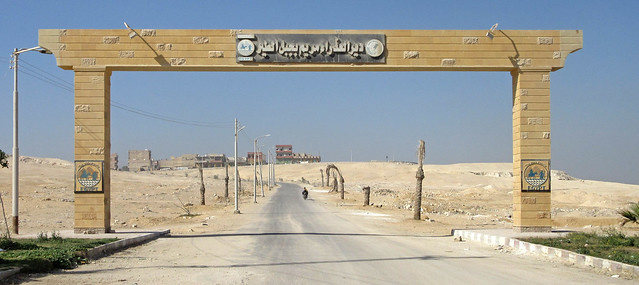After breakfast and our brief tour of the Coptic religious sites near the Holy Family Hotel, we drove an hour and a half south to visit Amarna, the ancient city where pharaoh Akhenaten moved the capital of Egypt in 1348 B.C. to establish his monotheistic temple dedicated to the worship of the sun god, Aten.
Ever since encountering Akhenaten in the Egyptian Museum on Tahrir Square on one of my first trips to Egypt, I have been intrigued by him. According to at least one Yale professor of medicine, the feminine features and elongated head of ancient Egypt’s King Akhenaten may be attributed to two genetic defects. Linda has been equally fascinated with Akhenaten and enthusiastically pointed out that our trip to Minya would put us within easy reach of his palace and temple.


The brief 17 year rule of Akhenaten, with his queen Nefertiti by his side, followed by their son, Tutankhamen, marked incredible change and reversal in ancient Egypt. Akhenaten banned the worship of the many traditional gods of Egypt and permitted only the worship of one god, Aten. This put a lot of priests and other government officials out of work! After Akhenaten passed from the scene and was succeeded by his son, Tutankhamen, worship of the traditional gods was resumed. The capital was returned to Luxor, and the city of Amarna was allowed to decay. The name of Akhenaten was erased from monuments and statues of him were destroyed. He became a "non-pharaoh."
But while he was still in power, he dominated the scene. The reign of Akhenaten even merits its own named era:

The drive from the hotel to Amarna presented only the uniform desert environment that covers most of the the Egyptian landscape. This was particularly the case as we turned off of the eastern desert freeway and journeyed the last few miles toward the town of Mallawi and approached the Nile.
Finally, as we approached the river driving through a deep cut in the surrounding limestone, rich agricultural land appeared and, surprisingly, a large modern-era cemetery.


Turning south toward Amarna, just before reaching the Nile, we entered the area containing the ancient city. The steep cliffs on the left side pull back quickly to reveal a very flat desert plain several miles wide and perhaps seven miles long, although the cultivated area near the river extends no more than a half mile into this plain.
Looking toward the right, we noticed a few fishermen on the Nile who were exploring the waters just as their families have done for thousands of years.
The Amarna archeological site is quite large, and civilization has encroached upon it in recent years. We pulled into the rest house and ticket office where Roshdy was questioned about our purpose and length of stay.




Security is of great concern to the authorities in the Minya area because of occasional clashes between the religious groups. We had police escorts throughout our trip including assigned plain-clothes officers. Roshdy had prepared an itinerary for the police in advance and we were required to stick to it, for the most part.

Meanwhile, Linda had the opportunity to strike up a conversation with this lady, Hyat, who was offering handmade baskets for sale. The baskets were of supreme quality and Linda purchased two of them. Hyat has been part of the staff at the rest house for several decades.

We paused for morning tea and arranged for a lunch to be prepared for us when we returned from touring the site.


After tea, we headed off a few miles into the distant hills along a winding road to view the tomb of Akhenaten. While there are many tombs of lesser figures easily accessible on the cliffs near the river, Akhenaten dug his several miles back among the rocky wadis (canyons) that wind throughout the area. There is not a sign of vegetation to be found along the way.

The architecture of the tomb is identical to those found in the Valley of the Kings at Luxor. A long sloping ramp leads down to the actual burial chamber. Decorations on the walls record the king's achievements.



Over the years, there has been considerable floodwater damage to the tomb, erasing the color so prominent in many Egyptian tombs - but there are surviving decorations and inscriptions hinting at what must have been magnificent monuments to the sun-god, Aten.



Returning to the guest house, we were served a wonderful Egyptian lunch by Hyat and her brother.

A glance at the map of the Amarna site quickly reveals that it takes far more than our half-day to tour the area in depth. Many visitors to the site hike up to the North Tombs on the hillside where numerous images are found inside. We decided instead, to visit the remnants of Akhenaten's North Palace.
Here is a glance at the North Tombs as seen from below:




The North Palace has been partially restored to reveal the size and layout. To accomplish the construction of this palace and the many other buildings associated with Amarna as a new capital city during the brief seventeen year reign of Akhenaten required both hard work and innovation. The construction was accomplished with a new style of much smaller standardized limestone blocks know as Talatat. Capable of being handled by a single construction worker, these blocks boosted productivity to new levels.
The Talatat blocks were initially used in new temples and extensions at Luxor before appearing at Amarna. The new Talatat blocks were abandoned as a construction tool after Akhenaten's time. Unfortunately, they were just as easily dismantled as they were assembled and this probably contributed to the ultimate destruction of the city.




Linda captures one more image of the palace under the watchful eye of the palace armed guard as neighborhood children watch us with curiosity.
Up to this point, I have only discussed the east bank area of the ancient city of Amarna. But the total area included a large section on the west bank of the Nile also. The total area was about 12 miles wide and 9 miles in length. Akhenaten marked the area carefully with as series of monumental boundary stela (stone tablets) of which 16 are currently known. Two are well preserved and accessible; we will visit one in a later blog post. The east bank section of Amarna was easily defended from both ends owing to the constricted entrances between the river and the steep cliffs at each end.
As we left Amarna and crossed the Nile at the bridge just south of the modern town of Mallawi, toward our next stop, we noted a passing Nile cruise ship heading south. The photo shows the stark contrast between the desert hills containing the tombs and the fertile floodplain along the river.

Additional Resources
There are numerous resources online as well as printed that serve as a guide to this fascinating area.
A history of the discovery, exploration and excavation at Amarna can be found at this page of the Amarna 3D site.
The Amarna 3D Project shares 3-dimensional digital reconstructions of much of the area.
The Amarna Project website has many photos, maps and reconstructions. Follow any of the links on its index page here.
The 1954 book titled Nefertiti Lived Here by Mary Chubb can be found online in the Internet Archive and may also be available at your local library.
The first of the Amelia Peabody novels by Elizabeth Peters, Crocodile on the Sandbank, is set primarily at Amarna as Amelia stumble into the world of Archeology in the late 19th century. (The book was written in 1974 and Peters has both a PhD in Egyptology as well as a marvelous understanding of the state of early archeology.)
National Geographic's television series, Lost Treasures of Egypt Season 5, Episode 10 - Tutankhamun’s Secret Revolution - tells the story of Amarna's rise and fall.













































